Alumni and Past Projects

Nuclear Analytical

-
Leonard Demoranville,
Nuclear Analytical
(some) Group Alumni

-
Richard Bindel,
-
Heavy Ions
-
 Lesley D’Orazio
Lesley D’Orazio -
 Paul Diss
Paul Diss -
 Laura Hainsworth
Laura Hainsworth -
 Walter Kehoe
Walter Kehoe -
 Bruce Libby
Bruce Libby -
 Alfredo Marchetti
Alfredo Marchetti -
 John Stanskas
John Stanskas -
 Scott Tumey
Scott Tumey -
 John Wells
John Wells -
 Jeff Zboray
Jeff Zboray
-
Abigail Bickley,

-
Heavy Ions

Heavy Ions
The PHOBOS experiment at the Relativistic Heavy Ion Collider (RHIC) at Brookhaven National Laboratory operated from 2000 through 2005. The detector is comprised of many different sub-detectors arranged around a nominal interaction point. The majority of data from PHOBOS comes from silicon detectors, while the remaining use scintillators or Cerenkov radiators to detect particles.
The PHOBOS experiment is used to investigate the phase diagram of nuclear matter at very high temperature and low baryon chemical potential. Under these conditions, quantum chromodynamics predicts a deconfinement of quarks from their hadronic boundaries, and this is believed to result in a phase transition to a quark gluon plasma (QGP).1
1 R. Bindel PhD thesis
The PHOBOS experiment is one of two smaller RHIC experiments, with 45 collaborators in 8 institutions from 3 countries.
-
Select publications/talks:
-
•System size, energy and pseudorapidity dependence of directed and elliptic flow at RHIC, Steven Manly for the PHOBOS Collaboration, Nucl. Phys. A774, 523 (2006).
-
•B.B. Back et. al., "Energy dependence of directed flow over a wide range of pseudorapidity in Au+Au collisions at RHIC", Phys. Rev. Lett. 97, 012301 (2006).
-
•“Systematic study of directed flow at RHIC energies”, Alice Mignerey for the PHOBOS Collaboration, Poster Proc. QM2005, Nukleonika 51 (Supplement 3), S29 (2006).
-
•“System Size and Energy Dependence of Elliptic Flow”, Alice Mignerey (for the PHOBOS Collaboration), Proc. of PANIC 2005, AIP Conference Proceedings p. 134 (2006).
-
•RHIC White Papers, Nucl. Phys. A 757 (2005) 28.
-
•B.B. Back et al. (PHOBOS Collaboration), “The PHOBOS Detector at RHIC”, Nucl. Inst. Meth. A 499, 603 (2003).

The PHOBOS Detector, 2004
SpecCal and PCAL not shown
R. Bindel PhD thesis


Past projects



Nuclear forensics uses analytical techniques to assist in the attribution of interdicted nuclear materials. To this end, part of the Mignerey group is working to develop improved analytical techniques. In particular, we are working to develop a concept called mass-filtered, time-dilated time-of-flight spectrometry. Mass filtering prior to time-of-flight analysis removes extraneous species. Inside the mass filter, time dilation lengthens the flight path with increasing mass in a predictable manner. Benefits derived from time dilation and mass filtering include improved duty cycle, shorter analysis time, increased precision, and better mass resolution; in other words, greater throughput of samples. Development of this technique has begun using the Naval Research Laboratory’s Trace Element Accelerator Mass Spectrometry (TEAMS) facility and SIMION 8.0 modeling.

gas detector
mass filtered Time of Flight AMS
References:
MF-TD-TOF
Experimental demonstration of mass-filtered, time-dilated, time-of-flight mass spectrometry. L. T. Demoranville, K. S. Grabowski, D. L. Knies, C. Cetina, Surface and Interface Analysis, 2010, DOI 10.1002/sia.3524
Testing of mass filtered, time dilated, time-of-flight mass spectrometry L. T. Demoranville, D. L. Knies, K. S. Grabowski, A. C. Mignerey J Radioanal Nucl Chem 282, 2009, 305 DOI 10.1007/s10967-009-0260-y
Genesis Project
Evaluation of standards for silicon analysis in germanium Genesis collectors by SIMS-AMS. C. Cetina, L.T. Demoranville, K.S. Grabowski, and D.L. Knies, Proceedings of the 41th Lunar and Planetary Science Conference, 2010, http://www.lpi.usra.edu/meetings/lpsc2010/pdf/2729.pdf
SIMS-AMS METHOD FOR MEASURING SOLAR WIND SILICON IN DLC GENESIS COLLECTORS. C. Cetina, K.S. Grabowski, D.L. Knies, and L.T. Demoranville, Proceedings of the 40th Lunar and Planetary Science Conference, 2009, http://www.lpi.usra.edu/meetings/lpsc2009/pdf/2550.pdf

doi:10.1016/j.apsusc.2008.05.055
Other:

Nuclear Forensics with TEAMS at the NRL


Eric Richardson,
-
Heavy Ions
Analytical Techniques: Environmental

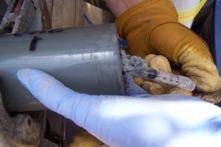
“The Application of Compound Specific Radiocarbon Analysis for Microbial Communities Responsible for Anaerobic Oxidation of Methane”
There has recently been a great deal of interest in the origin and fate of methane hydrate formations in ocean sediments. An interface exists in ocean sediment where methane oxidizing archaea and sulfate reducing bacteria (SRB) coexist, but the exact role of each in the anaerobic oxidation, CH4 + SO4-2 → HCO3- + HS- + H2O, of methane is unclear. Determining the radiocarbon age of lipid biomarkers specific to the SRB will elucidate the metabolic pathways of the microbial community in this anoxic, sulfate enriched environment. For example, if the SRB is living purely off of the archaea methane oxidation, it should have a dead radiocarbon age (~900‰). A contribution from dissolved inorganic carbon (DIC) derived from the seawater column will dilute this signature.

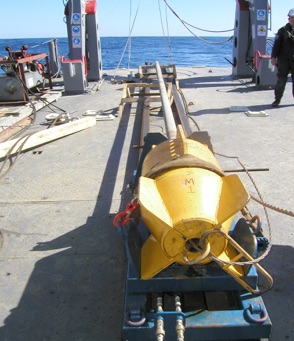
sample collection at sea

-

-
Heavy Ions

Heavy Ions

Marguerite Belt Tonjes,
Heavy Ions
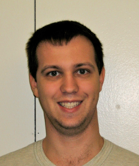
Nuclear Analytical

Analytical Nutrition





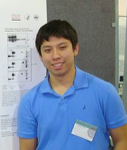
Nuclear Analytical

Analytical

Nuclear forensics is a growing field that utilizes analytical and radiochemical techniques to assist in the attribution of interdicted nuclear materials or to determine the original device used in a detonation event.
This research focuses on the pre-detonation side of nuclear forensics by focusing on spent nuclear fuel from a research reactor. When fission occurs, whether in a bomb or a nuclear reactor, two fission peaks occur at a high and low mass. On the tail end of the high mass peak lanthanoid isotopes are produced in ratios that are very different from natural. The production of these lanthanoid isotopes are perturbed based on the energy of the neutrons and on the fuel undergoing fission.
This research measures the lanthanoid isotopic ratios in spent research reactor nuclear fuel. These lanthanoid isotopic ratios will allow us to constrain models to better determine what type of research reactor produced the spent fuel. To this end this research consists of three main goals: separation of the lanthanoids, precise isotopic measurements, and working with theoreticians on constraining ORIGEN (a spent nuclear fuel model) to better handle research reactor cores.
Nuclear Forensics


Above: column extraction
Right: Isotopic ratio determination

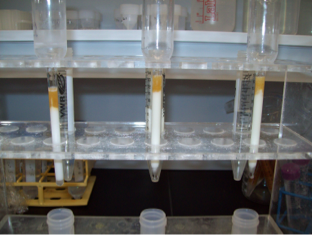

Fingerprints are a topic which has been researched for centuries, but mostly with regards to the development of latent prints and comparison of the developed print to a known print. More recently the actual chemical makeup of fingerprints has been of interest for a variety of reasons, one of which is the possibility of age dating. This project focuses on utilizing a variety of techniques to see if there are chemicals in fingerprints which act as molecular chronometers. To do so fingerprints are artificially aged in controlled settings and analyzed by one, or several, techniques including C60+ SIMS, API-MS, GC-MS, IR microscopy, or SEM-EDS. Currently the focus is on the degradation of sebaceous materials present in a fingerprint. The long-term goal is development a method which could allow crime labs to estimate the age of a fingerprint by determining the relative amounts of certain compounds present in the fingerprint. This would allow investigators to determine whether or not the fingerprint is criminally relevant, or provide an approximate time of when a crime occurred.
Work in collaboration with the Surface and Microanalysis Science Division at the National Institute of Standards and Technology and the United States Army Criminal Investigations Laboratory.


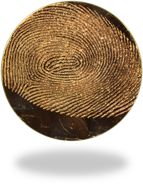
Photo of an aged fingerprint
Forensics

“Purple Pepper Plants: An Anthocyanin Powerhouse”
Separation, isolation and characterization of the major anthocyanin (ACN) in the foliage of Capsicum annuum L., a unique purple pepper containing high concentrations of one major ACN (delphinidin-3-p-coumaroylrutinoside-5-glucoside), intended for food grade preparation to determine potential health benefits. Liquid chromatography, mass spectrometry and nuclear magnetic resonance were used to separate and identify the ACN. Once separated and concentrated, the extract was analyzed for composition, structural elucidation and correlation to standards. The long-term goal is to utilize this extract as a mainstream supplement following completion of extensive human nutrition and toxicological studies to understand its bioavailability and metabolic pathways.

Work in the Plant Sciences Institute of the USDA, as part of the Genetic Improvement of Fruits and Vegetables Lab (GIFVL). In collaboration with the Beltsville Human Nutrition Research Center (BHNRC)


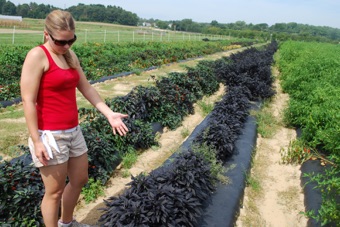
Nutrition


page last edited:
February 4, 2017, by MBT

Copyright © 2008-2017. The Department of Chemistry and Biochemistry. All rights reserved




